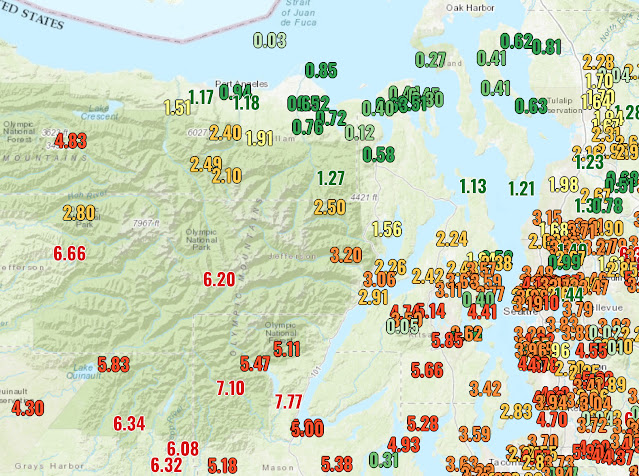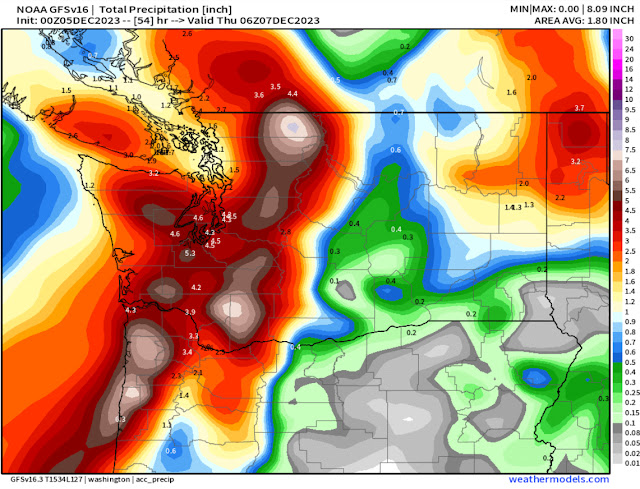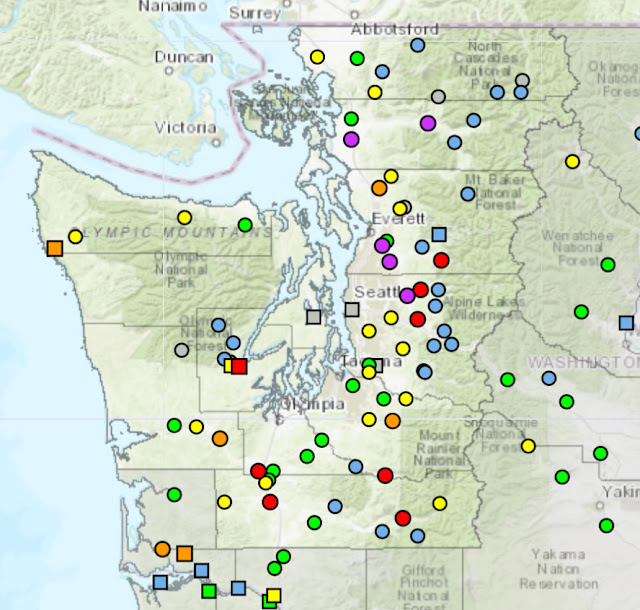FastCast—Saturday, Dec. 9 to Tuesday, Dec. 12:
The next atmospheric river is ahead for the Pacific Northwest, bringing another round of rain, heavy at times, and heightening the landslide risk. Rivers will rise again, but likely not reaching flood stage, except the Skokomish River in Mason County, which will reach minor flood stage. The Snoqualmie River may reach bankfull through the valley. For the lowlands, expect 1-1.5” of rain from Saturday to Sunday evening. Temperatures will drop to the low to mid 30s by Saturday morning, only rising to the mid 40s on Saturday. This presents an interesting possibility of BRIEF snowflakes across the lowlands as precipitation begins on Saturday morning. The best chance of seeing brief snow is on the Kitsap Peninsula, on higher hills, and in scattered areas from Everett northward. Additionally, expect winds gusting 45-55 mph from Everett northward on Saturday, potentially up to 60 mph for the San Juans. Temperatures will continue rising overnight and into Sunday morning, with highs on Sunday reaching the low 50s across the lowlands. Rain will end across the lowlands by Sunday evening. Monday and Tuesday will be partly cloudy with highs in the mid 40s and lows in the mid 30s. In the mountains, expect 8-12” at the passes of snow on Saturday, before snow levels increase to 5,000-6,000 feet by Sunday morning. Note that there is a chance of freezing rain at Snoqualmie and Stevens Passes on Sunday, before a transition to rain. This could bring additional travel impacts to the passes, so stay aware.
———————————————————
Continue reading the full blog below!
The next atmospheric river is ahead for the Pacific Northwest, with rain and mountain snow ahead, before mountain snow changes to rain. Additionally, we’ll take a look at the slight chance of BRIEF snowflakes in the lowlands on Saturday. Let’s take a look at the forecast!
Below is the European model forecast showing the atmospheric river aimed at the Northwest on Saturday evening.
Notice the tongue of moisture (significantly weaker than last time), aimed at the Northwest. This is what will bring the next round of rain to the region over the weekend.As rain begins across the region on Saturday morning to midday, colder air from a chilly night will still be in place, with temperatures across the lowlands likely in the mid 30s. Once heavier rain starts falling, this can lead to adiabatic cooling, where the process of heavier precipitation falling saturates the atmosphere and cools the air enough for snowflakes to mix in with the rain. This can typically happen when the temperature is 34º or cooler in Western Washington.
Below is the HRRR high-resolution forecast showing what the weather radar could look like midday Saturday.
Notice how this forecast shows snow (blue) across the foothills, parts of the lowlands, and the Kitsap Peninsula, and look around the areas of potential snow…around snow is heavy rain, showing that snow will only fall due to heavy rain moving in. This is a “low confidence” scenario, but some snowflakes are possible. Brief snow accumulations aren’t likely, but if that does happen it would likely be relegated to the higher hills of the Kitsap Peninsula. Snow is also possible across the Vancouver BC metro area, due to colder air moving out of the Fraser River Valley. Again, any snowflakes will be brief, as the atmospheric river will overwhelm the snow and bring a quick return to rain.
Let’s take a look at the snow forecast for the state, seen below on the European model.
The European model does show light snow for the Kitsap Peninsula and a potential to see some brief snow from Everett northward. This forecast shows 8-16” in the passes and 4-6” from I-90 northward in Eastern Washington, with a potential for 5-6” around Spokane. All snow will fall by midday Sunday for the Cascades and Eastern WA.Let’s compare this to the NAM high-resolution forecast for snow in Western WA, seen below.
The NAM forecast shows accumulating snow on the Kitsap Peninsula, in the foothills, and in some areas from Everett northward. This is likely overdone, and most areas that have accumulating snow in the forecast will likely see brief snowflakes (maybe heavy snow, but not sticking). This forecast gives the passes 6-10” of snow, so prepare for travel impacts on Saturday into Sunday morning.Finally, before we shift to the rain forecast, below is the UW WRF high-resolution snow forecast.
This forecast is similar to the NAM, showing light snow potential around the lowlands, especially Everett northward, with accumulating snow on the Kitsap Peninsula. Again, this is likely overdone. The passes receive 8-16” in this forecast.Now, let’s take a look at rain. Below is the European model forecast for total rain through Monday morning.
The European model forecast shows the lowlands being somewhat rainshadowed, getting 0.8-1.2”, with the NW Interior getting 1-1.2”, areas from Olympia south and west getting 1.2-1.5”, and the coast getting 2-3”. The Willamette Valley gets similar amounts as the lowlands (1-1.3”) in this forecast. Eastern Washington may pick up 0.2-0.6” as well.Let’s compare this to the GFS (American) model, seen below, also showing total rain through Wednesday.
The GFS shows a much wetter solution for areas from Everett south. From Everett north, this forecast shows 0.8-1”. For Everett south, this forecast shows 1.5-2”, with the Willamette Valley getting 2-2.5” in this forecast, and the coast getting 1.5-3.5”. This forecast shows higher totals for Eastern Washington as well, especially from Spokane southward.Finally, strong SE winds are expected for the North Sound, Northwest Interior, and the San Juans on Saturday. Below is the HRRR high-resolution forecast showing expected peak winds.
The HRRR forecast shows winds gusting 40-50 mph from Everett northward, with gusts of 50-60 mph for the San Juan Islands, and 40-50 mph on the coast, except potentially up to 55-60 mph along the Western Strait (near Neah Bay) and Cape Flattery.Stay safe out there (especially in the mountains) and be prepared for standing water, low visibility, and heavy rain.























































